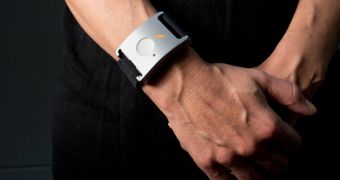A collaboration of American investigators announces the development of a wrist sensor that is extremely effective at gaging the severity of an epilepsy seizure. In fact, the system is almost identical in terms of performance to traditional electroencephalograms (EEG).
The latter are used to measure brain wave activity, an analysis that can reveal abnormalities associated with these seizures. However, EEG devices require the use of many wires and electrodes, and are not readily available during such an event.
This is where the new wrist band steps in. As seen in the image to the left, the device is easy and comfortable to wear, just like a watch, but provides monitoring performances similar to those of EEG.
The device was created by researchers at the Cambridge-based Massachusetts Institute of Technology (MIT), who worked closely with colleagues at two hospitals in Boston for this investigation. Details of how the device works appear in the latest issue of the scientific journal Neurology.
Patient monitoring devices are not new. Similar instruments exist for heart patients, who wear a series of electrodes wrapped around their bodies for 24 hours. A small central unit collects data on heartbeats as the individual goes about his or hers daily life.
Similarly, the wrist device created for monitoring epilepsy would analyze the severity of a potential seizure that may occur as the patient is wearing it. Having access to data covering the onset of seizures as well could be a boon for investigators seeking to develop new ways of addressing the condition.
At the same time, the instrument could also be designed in such a manner that it can alert its user when the intensity of epilepsy seizures is very severe, and may require hospitalization. The team that developed the instrument was led by MIT professor of media arts and sciences, Rosalind Picard.
“Some of these children have many, many seizures every day, and they actually suffer as much from overreaction to these seizures as, potentially, from not reacting to something dangerous,” Stephan Schuele explains.
The expert, who was not a part of the new study, holds an appointment as a director of the Epilepsy Center at the Northwestern University Medical Faculty Foundation.
“So I think the result is very valuable, particularly in this population, because it doesn’t respond 20 times a day to any seizures. It only responds if you do have a very, very severe seizure. And it seems to be reliably responding to that,” he concludes.

 14 DAY TRIAL //
14 DAY TRIAL //